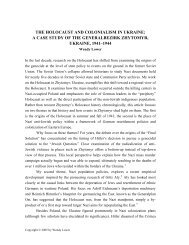Effects of Teachers' Mathematical Knowledge for Teaching on - Apple
Effects of Teachers' Mathematical Knowledge for Teaching on - Apple
Effects of Teachers' Mathematical Knowledge for Teaching on - Apple
You also want an ePaper? Increase the reach of your titles
YUMPU automatically turns print PDFs into web optimized ePapers that Google loves.
Hill, Rowan, & Ball<br />
directly address this issue. However, we did include in our analyses a measure<br />
<str<strong>on</strong>g>of</str<strong>on</strong>g> c<strong>on</strong>tent knowledge <str<strong>on</strong>g>for</str<strong>on</strong>g> teaching reading that was similar in intent<br />
to the CKT-M measure but designed to measure teachers’ knowledge <str<strong>on</strong>g>of</str<strong>on</strong>g><br />
and ability to teach word analysis and reading comprehensi<strong>on</strong>. If the CKT-<br />
R and mathematics measures both draw heavily <strong>on</strong> general knowledge <str<strong>on</strong>g>of</str<strong>on</strong>g><br />
teaching, they should be moderately to highly correlated and should share<br />
the positive relati<strong>on</strong>ship to student achievement seen in Model 1. In Model<br />
2, we included this CKT-R measure and found that although it was positively<br />
related to student gains in the first and third grades, it was not statistically<br />
significant. Furthermore, it had <strong>on</strong>ly a small effect <strong>on</strong> the absolute<br />
size and significance <str<strong>on</strong>g>of</str<strong>on</strong>g> the CKT-M variable. This suggests that the effect <str<strong>on</strong>g>of</str<strong>on</strong>g><br />
teachers’ knowledge <strong>on</strong> student achievement is at least c<strong>on</strong>tent specific and<br />
that, in mathematics, it reflects more than simply general knowledge <str<strong>on</strong>g>of</str<strong>on</strong>g><br />
teaching.<br />
Our models showed other significant or near-significant findings. For<br />
example, the average length <str<strong>on</strong>g>of</str<strong>on</strong>g> a teacher’s mathematics less<strong>on</strong> was significantly<br />
related to third-grade student gains, with a <strong>on</strong>e-standard-deviati<strong>on</strong><br />
increase in daily mathematics less<strong>on</strong> length—about 14 minutes—yielding<br />
an additi<strong>on</strong>al 1.8 points. This translates to roughly an additi<strong>on</strong>al 2 weeks<br />
<str<strong>on</strong>g>of</str<strong>on</strong>g> instructi<strong>on</strong> per year <str<strong>on</strong>g>for</str<strong>on</strong>g> a classroom that receives the additi<strong>on</strong>al 14 minutes<br />
per day. Teachers’ mathematics preparati<strong>on</strong> (i.e., the average number<br />
<str<strong>on</strong>g>of</str<strong>on</strong>g> c<strong>on</strong>tent and methods courses they completed in preservice or graduate<br />
training) positively predicted student gains in the third grade but was just<br />
outside <str<strong>on</strong>g>of</str<strong>on</strong>g> traditi<strong>on</strong>al significance (p = .06). The effects <str<strong>on</strong>g>of</str<strong>on</strong>g> another comm<strong>on</strong>ly<br />
argued policy soluti<strong>on</strong>, teacher certificati<strong>on</strong>, also were insignificant<br />
in this particular sample <str<strong>on</strong>g>of</str<strong>on</strong>g> teachers and students. Although certificati<strong>on</strong><br />
was mildly related to teachers’ knowledge <str<strong>on</strong>g>of</str<strong>on</strong>g> c<strong>on</strong>tent in the third grade<br />
(Table 5), it had no independent influence <strong>on</strong> student gain scores. This may<br />
reflect a true null effect, or it could have occurred because n<strong>on</strong>certified<br />
teachers had taken a comparable number <str<strong>on</strong>g>of</str<strong>on</strong>g> math methods and c<strong>on</strong>tent<br />
courses to the number taken by certified teachers (see Table 5). Thus, n<strong>on</strong>certified<br />
teachers may have been en route to traditi<strong>on</strong>al certificati<strong>on</strong> or may<br />
have been transferring to new schools from other states (Darling-Hamm<strong>on</strong>d,<br />
Berry, & Thores<strong>on</strong>, 2001) or mathematics-intensive pr<str<strong>on</strong>g>of</str<strong>on</strong>g>essi<strong>on</strong>s. This finding<br />
could also reflect the fact that certificati<strong>on</strong> requirements vary across the<br />
states included in our study.<br />
Years <str<strong>on</strong>g>of</str<strong>on</strong>g> teaching experience, measured linearly, showed no relati<strong>on</strong>ship<br />
to first-grade student achievement and a marginally significant (p = .11) positive<br />
relati<strong>on</strong>ship in the third grade. Some studies, however, have suggested<br />
that the teachers who negatively affect student achievement are those in the<br />
first several years <str<strong>on</strong>g>of</str<strong>on</strong>g> their career. We created a dummy variable representing<br />
teachers in their first or sec<strong>on</strong>d years <str<strong>on</strong>g>of</str<strong>on</strong>g> teaching and entered it into the models<br />
in place <str<strong>on</strong>g>of</str<strong>on</strong>g> the linear measure. The significance <str<strong>on</strong>g>of</str<strong>on</strong>g> this variable in the<br />
third-grade model did not change, but the measure <str<strong>on</strong>g>of</str<strong>on</strong>g> novice teachers did<br />
become marginally significant in the first-grade model (b =−5.3, p < .10).<br />
398




